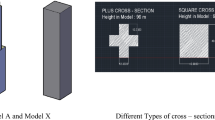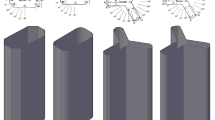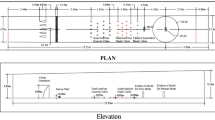Abstract
Wind effect is the most interesting and important parameter for different structural elements like sidewall, roof and around the building also. A number of researchers were presented their thoughtful inspections on different, unconventional tall buildings due to wind issue. The present study focuses on the pressure distribution around the square and setback tall buildings due to wind load. The models have single and double type setback at different elevations. The pressure calculation was conducted by analytical study of plane and highlights the pressure fluctuation. Some amount of pressure bulb was observed on the leeward side of setback model, which mean the increase of suction on that particular region. The excessive amount of suction envelop recognized at the top roof of setback model compared to square model.
Access provided by Autonomous University of Puebla. Download conference paper PDF
Similar content being viewed by others
Keywords
4.1 Introduction
According to architectural point of view, setback tall building always robbed the feather of elegance. Environmental effects like wind also claim to reveal around the building and its surrounding region. Mendis et al. [1] enumerated simple quasi-static treatment of wind load on tall buildings. Irwin et al. [2] established the energy in tall building increased with the increase in the height of a tall building. Kim et al. [3] carried out for three aeroelastic, tapered, tall building models with taper ratios of 5, 10 and 15%. Kim and Kanda [4] focused the wind pressure on the setback and tapered shape tall buildings in both static and dynamic for different flow condition. Tanaka et al. [5] studied the aerodynamic response due to wind and flow characteristics of tall buildings with thirty-four numbers unconventional shapes in wind tunnel test and CFD simulation. Bairagi and Dalui [6, 7] evaluated the interference effects, pressure coefficients and optimum distance on parallel high-rise buildings for different orientation using CFD. Mukherjee and Bairagi [8] studied the ‘N’ plan shape tall building and evaluated the pressure, force and velocity around the model. Mendis et al. [9] discussed a number of problems, mistakes and solutions for CFD wind analysis. Baby et al. [10] presented an overview of the optimal external shape and structural system for tall buildings subject to aerodynamic loads and the response of a structure through a comprehensive investigation of the building. Xu and Xie [11] focused the aerodynamic optimization of tall buildings and best compromise wind issues. Roy and Bairagi [12] discussed wind pressure and force coefficients on stepped tall building at different geometrical shape placed on above to each other like rectangular, square and triangular. Tamura et al. [13] conferred pedestrian level and aerodynamic wind characteristics of super-tall buildings with various configurations and conducted the dynamic wind response. Mittal H et al. [14] investigated the effect of building shape (square, tapered and setback) and wind direction on pedestrian level. Bairagi and Dalui [15] discussed comparison of aerodynamic coefficients between two setbacks tall buildings due to wind load. Namchu et al. [16] highlighted the pressure coefficients on tall chimney for different wind terrain condition. Bairagi and Dalui [17] highlighted the aerodynamic effects and power spectral density on setback roof compare to the top roof of setback model. Bairagi and Dalui [18] focussed on pressure coefficient on square and both side setback tall building and concluded the pressure coefficient of the setback roof was 205.4% more effective than the top roof. The present study discussed the pressure coefficient around the square and the setback tall building at different plane for along and across wind condition.
4.2 Description of Model
Different types of unconventional modes were analyzed by the wind tunnel test and the test is expensive. To overcome this situation, computational fluid dynamics (CFD) is a widely acceptable simulation process of wind analysis. This study based on this type of simulation. Three sets of models, namely S1, S2 and S3, are used in this study. All the models have l/b ratio is 1 and the h/b is 2. The S1 model has same plan area along height, but S2 and S3 changed their plan area h/2 and h/3 level from the ground. The S2 model has 20% setback at h/2 level and S3 has 10% setback at each h/3 and 2h/3 level. The attacking wind angles are from 0° to 180° at 15° interval. The considered h, b and l are 500 mm, 250 mm and 250 mm, respectively (see Fig. 4.1).
4.3 Analytical Domain and Mesh
The three models were placed inside the domain for CFD simulation. The boundary of domain has been set 5H from inlet and both sidewalls and 6H from the base of model as stated by Frank et al. [19], Revuz et al. [20] (see Fig. 4.2a). Here, H is the height of the analytical model. The boundary conditions for different walls and different non-dimensional parameters are stated in Table 4.1.
Where U is the horizontal wind speed at an elevation Z; UH is the speed at the reference elevation ZH; which was 10 m/s; ZH is 1.0 m; k is the kinetic energy of turbulence and ε is the dissipation rate; Uavg is the mean velocity at the inlet; I is the turbulence intensity; l is the turbulence length scale; Cμ is the turbulence model constant, i.e., 0.09. The mesh detail of the S1 model (see Fig. 4.2b).
4.4 Comparison with Analytical Study
The analytical study validated with the experimental study of square model discussed by Kim and Kanda [21]. The experimental study was conducted in Eiffel-type wind tunnel at the University of Tokyo. The experimental model had L = 100 mm, B = 100 mm, H = 400 mm and length scale 1/400 with α = 0.13. The blockage ratio was 1.2% with wind flow at 6.5 m/s. The simulated square model has the same aspect ratio and has same non-dimensional parameters adopted by the author. The validation of turbulence intensity and mean wind speed as shown in Fig. 4.3.
Validation of turbulence intensity and mean wind speed of square model with Kim and Kanda [21] and present study
4.5 Results and Discussion
Pressure contour around the models S1, S2 and S3 are presented in this study. The pressure distribution on YZ and XZ plane has been studied for along the wind and across wind conditions. Figure 4.4a shows the wind pressure contour at YZ plane and at the center of model for along wind condition for S1 model. For along wind condition, the windward face encircled by the ranged from 1.2 to 0.1 and the top and leeward faces ranged from −0.1 to −0.5. In this connection, the excessive amount of suction shown in purple color at −0.5 on leeward zone. Similarly, the pressure contour at the XZ plane and the center of the model for across wind conditions showcased in Fig. 4.4b. For this condition, the pressure envelope ranged from −0.1 to −0.75 and the values are high suction. A comparative study also carried out between S2 and S3 models on YZ and XZ plane for 0°, 90° and 180° wind incidence angles as shown in Table 4.2. Mou et al. [22] found the large amount of pressure difference on leeward surface further established the negative and positive pressure around the building depends upon the width of the building. No special change has been focused for along wind condition for 0° wind on YZ and XZ plane except the bulb region on the leeward face of S2 and S3 models compared to S1 model. However, large amounts of pressure variant take place on opposite sides of the setback face on the YZ plane for 90° wind angle. S2 model has line −0.85 near the top and bottom of setback zone. However, S3 model has the same line at the lowest part of setback zone. A beautiful violet color zone (−0.7) observed between Y ranges from 0.1 to 0.2. Simultaneously, model S2 has a light green color (−0.45) on that particular Y range. For along wind condition on the XZ plane has a pressure contour line −0.3, which covered in most of the area for the S3 model. However, S2 model has a line range from −0.2 to −0.6. Therefore, it is clear that the large amount of suction developed in the leeward region due to decrease of number of setback roof for 90° wind angle. For 180° wind angle, the windward face has line 1.2 and −0.1 at the leeward face of S2 model. On the other hand, the S3 model has a large area of line −0.6 on the leeward side, but no lines of 1.2 are visible at windward face. The XZ plane for 180° wind angle has large amount of suction on the top roof at line −0.7 for S2 model and line −0.6 at the rooftop of S3 model. It is clear that the pressure on top of the setback roof has maximum suction (−0.7) for S2 model compared to S1 model (−0.35).
4.6 Conclusion
The present paper focused on the wind pressure variation around the square and different setback models for along the wind and across the wind conditions. The following conclusions are made after a lot of analytical simulations.
-
The leeward pressure is maximum on S1 model for 0° wind of line −0.5. A bulb region created on the leeward side of S2 and S3 models of line −0.4.
-
The excessive amount of suction matured at leeward side due to decrease of number of setback roof for 90° wind angle.
-
The pressure coefficient is quite large for along wind condition on S2 model for 180° wind angle.
-
The pressure on the rooftop of S1 model has maximum compared to other two models.
References
Mendis, P., Ngo, T., Haritos, N., Hira, A., Samali, B., Cheung, J.: Wind loading on tall buildings. Electron. J. Struct. Eng. Special Issue: Loading on Structures. 41–54 (2007)
Irwin, P., Kilpatrick, J., Robinson, J., Frisque, A.: Wind and tall buildings: negatives and positives. Struct. Des. Tall Spec. Build. 17, 915–928 (2008)
Kim, Y.M., You, K.P., Ko, N.H.: Across-wind responses of an aeroelastic tapered tall building. J. Wind Eng. Ind. Aerodyn. 96, 1307–1319 (2008)
Kim, Y.C., Kanda, J.: Wind pressures on tapered and set-back tall buildings. J. Fluids Struct. 39, 306–321 (2013)
Tanaka, H., Tamura, Y., Ohtake, K., Nakai, M., Kim, Y.C., Bandi, E.K.: Aerodynamic and flow characteristics of tall buildings with various unconventional configurations. Int. J. High-Rise Build. 2, 213–228 (2013)
Bairagi, A.K., Dalui, S.K.: Evaluation of interference effects on parallel high-rise buildings for different orientation using CFD. In: 3rd World Conference on Applied Sciences, Engineering & Technology, pp. 764–774. Kathmandu, Nepal (2014)
Bairagi, A.K., Dalui, S.K.: Optimization of interference effects on high-rise building for different wind angle using CFD simulation. Electron. J. Struct. Eng. 14, 39–49 (2014)
Mukherjee, A., Bairagi, A.K.: Wind pressure and velocity pattern around ‘N’ plan shape tall building—A case study. Asian J. Civil Eng. (BHRC) 18(8), 1241–1258 (2017)
Mendis, P., Mohotti, D., Ngo, T.: Wind design of tall buildings, problems, mistakes and solutions. In: 1st International Conference on Infrastructure Failures and Consequences, Melbourne, Australia (2014)
Baby, S., Jithin,, P.N., Thomas, A.M.: A study of wind pressure on tall buildings and its aerodynamic modifications against wind excitation, Int. J. Eng. Dev. Res. 3 (2015)
Xu, Z., Xie, J.: Assessment of across-wind responses for aerodynamic optimization of tall buildings. Wind Struct. 21, 505–521 (2015)
Roy, K., Bairagi, A.K.: Wind pressure and velocity around stepped unsymmetrical plan shape tall building using CFD simulation—A case study. Asian J. Civil Eng. (BHRC) 17, 1055–1075 (2016)
Tamura, Y., Xua, X., Tanakac, H., Kima, Y.C., Yoshidaa, A., Yangd, Q.: Aerodynamic and pedestrian-level wind characteristics of super-tall buildings with various configurations. In: 10th International Conference on Structural Dynamics, EURODYN, vol. 199, pp. 28–37. Procedia Engineering (2017)
Mittal, H., Sharma, A., Gairola, A.: Pedestrian level wind characteristics around tall buildings: effect of building shape and wind direction. In: 9th Asia-Pacific Conference on Wind Engineering, Auckland, New Zealand (2017)
Bairagi, A.K., Dalui, S.K.: Comparison of aerodynamic coefficients of setback tall buildings due to wind load. Asian J. Civil Eng. Build. Housing 19, 205–221 (2018)
Namchu, A.D., Bairagi, A.K, Chakroborty, S.: Aerodynamic coefficients of steel stacks under different terrain category. In: Proceeding of International Conference on Frontier in Engineering, Applied Science and Technology, (FEAST’18), pp. 133–138. NIT Tiruchirappalli (2018)
Bairagi, A.K., Dalui, S.K.: Aerodynamic effects on setback tall building using CFD simulation. In: 2nd International Conference on Advances in Dynamics, Vibration and Control, pp. 381–388. NIT Durgapur (2018)
Bairagi, A.K., Dalui, S. K.: Comparison of pressure coefficient between square and setback tall building due to wind load. In: SEC18: Proceedings of the 11th Structural Engineering Convention—2018. Jadavpur University, Kolkata, India (2018)
Franke, J., Hirsch, C., Jensen, A., Krüs, H., Schatzmann, M., Westbury, P., Miles, S., Wisse, J., Wright, N.G.: Recommendations on the use of CFD in wind engineering. In: COST Action C14. Impact of Wind and Storm on City Life and Built Environment. Von Karman Institute for Fluid Dynamics (2004)
Revuz, J., Hargreaves, D.M., Owen, J.S.: On the domain size for the steady-state CFD modelling of a tall building. Wind Struct. 15 (2012)
Kim, Y.C., Kanda, J.: Characteristics of aerodynamic forces and pressures on square plan buildings with height variations. J. Wind Eng. Ind. Aerodyn. 98, 449–465 (2010)
Mou, B., Heb, B.J., Zhaoc, D.X., Chaud, K.: Numerical simulation of the effects of building dimensional variation on wind pressure distribution. Eng. Appl. Comput. Fluid Mech. 11(1), 293–309 (2017)
Author information
Authors and Affiliations
Corresponding author
Editor information
Editors and Affiliations
Rights and permissions
Copyright information
© 2020 Springer Nature Singapore Pte Ltd.
About this paper
Cite this paper
Bairagi, A.K., Dalui, S.K. (2020). Distribution of Wind Pressure Around Different Shape Tall Building. In: Vinyas, M., Loja, A., Reddy, K. (eds) Advances in Structures, Systems and Materials. Lecture Notes on Multidisciplinary Industrial Engineering. Springer, Singapore. https://doi.org/10.1007/978-981-15-3254-2_4
Download citation
DOI: https://doi.org/10.1007/978-981-15-3254-2_4
Published:
Publisher Name: Springer, Singapore
Print ISBN: 978-981-15-3253-5
Online ISBN: 978-981-15-3254-2
eBook Packages: EngineeringEngineering (R0)








